
The NatureServe conservation status system, maintained and presented by NatureServe in cooperation with the Natural Heritage Network, was developed in the United States in the 1980s by The Nature Conservancy (TNC) as a means for ranking or categorizing the relative imperilment of species of plants, animals, or other organisms, as well as natural ecological communities, on the global, national or subnational levels. These designations are also referred to as NatureServe ranks, NatureServe statuses, or Natural Heritage ranks. While the Nature Conservancy is no longer substantially involved in the maintenance of these ranks, the name TNC ranks is still sometimes encountered for them.
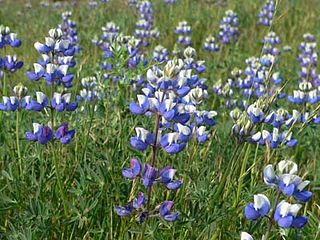
Lupinus nanus, the sky lupine, field lupine, dwarf lupin, ocean-blue lupine or Douglas' annual lupine, is a species of lupine native to the western United States. It is found natively in California, Nevada, and on Steens Mountain in eastern Oregon. It tends to grow on slopes and in open or disturbed areas below 1300 meters.
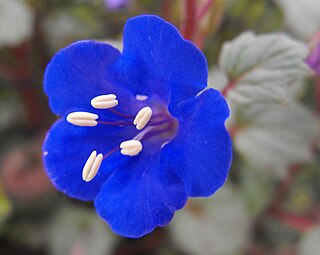
Phacelia campanularia is a species of flowering plant in the borage family, Boraginaceae, known by the common names desertbells, desert bluebells, California-bluebell, desert scorpionweed, and desert Canterbury bells. Its true native range is within the borders of California, in the Mojave and Sonoran Deserts, but it is commonly cultivated as an ornamental plant and it can be found growing elsewhere as an introduced species.

The Lanphere Dunes National Natural Landmark a unit of the Humboldt Bay National Wildlife Refuge Complex, is located in Humboldt County, California. The dune complex consists of the wave slope, fore dune, herbaceous and woody swales, coniferous and riparian forest, freshwater swamp, freshwater marsh, brackish marsh, salt marsh, and intertidal mudflats. The site exemplifies dunes succession.
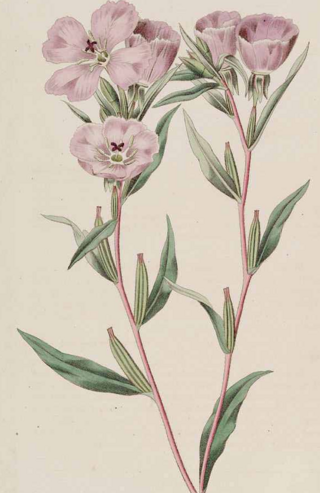
Clarkia purpurea is a species of wildflower known by the common names winecup clarkia, winecup fairyfan, and purple clarkia.
Erythronium pluriflorum is a rare species of flowering plant in the lily family Liliaceae which is known by the common names manyflower fawn lily,golden fawn-lily, and Shuteye Peak fawn lily.
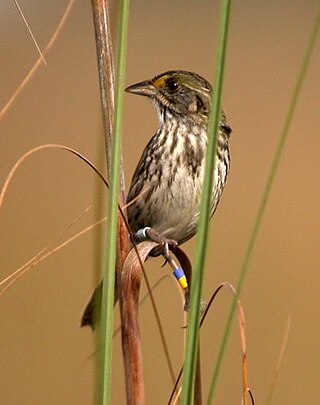
The Cape Sable seaside sparrow is a subspecies of the seaside sparrow, a species of bird in the family Passerellidae native to the United States. This subspecies is endemic to southern Florida. It is designated endangered under the Endangered Species Act.
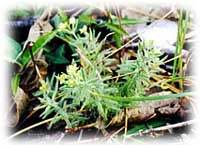
Galium californicum is a species of flowering plant in the coffee family known by the common name California bedstraw.

Cordylanthus rigidus is a species of flowering plant in the family Orobanchaceae known by the common name stiffbranch bird's beak.
Clarkia tembloriensis is a rare species of flowering plant in the evening primrose family, known by the common name Temblor Range clarkia and belonging to the Onagraceae family.

Chloropyron molle is a species of flowering plant in the family Orobanchaceae.
Cordylanthus nevinii is a species of flowering plant in the family Orobanchaceae known by the common name Nevin's bird's beak. It is native to pine and oak forests and woodlands in southern California, western Arizona, and northern Baja California.

Cordylanthus nidularius is a rare species of flowering plant in the family Orobanchaceae known by the common name Mt. Diablo bird's beak.

Chloropyron palmatum is an endangered species of salt-tolerant, flowering plant in the family Orobanchaceae. It is a low, highly branched herbaceous annual with each flower enclosed by a single, characteristically palmate bract. It is known by the common names of palmate salty bird's-beak and palmate-bract bird's-beak.

Tijuana Slough National Wildlife Refuge is located in the most southwestern corner of the contiguous United States. As a National Wildlife Refuge, it is administered by the U.S. Fish and Wildlife Service. It was established in 1980.
Navarretia rosulata is a rare species of flowering plant in the phlox family known by the common names San Anselmo navarretia, Marin County navarretia, and Marin County pincushionplant.

Sidalcea calycosa is a species of flowering plant in the mallow family known by the common names annual checkerbloom, checker mallow, and vernal pool checkerbloom.

Sidalcea malviflora is a species of flowering plant in the mallow family, known by the common names dwarf checkerbloom, Greek mallow, prairie mallow and dwarf checkermallow.

Chloropyron is a genus of plants in the botanical family Orobanchaceae. The plants of this group were formerly classified in the subgenus Hemistegia of the genus Cordylanthus, but were elevated to genus level by David C. Tank, John Mark Egger and Richard G. Olmstead in 2009 after molecular phylogenetic work.
The Alkali Sink Ecological Reserve is a protected conservation area spanning approximately 930 acres in the Central Valley of California. The reserve contains a variety of habitats, such as alkali sink scrub and annual grasslands, and serves as an essential refuge for numerous migratory birds, waterfowl, and endangered species. Established in 1979 by the Fish and Game Commission, the reserve aims to preserve the remaining Alkali Sink Scrub habitat, which has been largely extirpated due to agricultural expansion, urbanization, and infrastructure development.
















